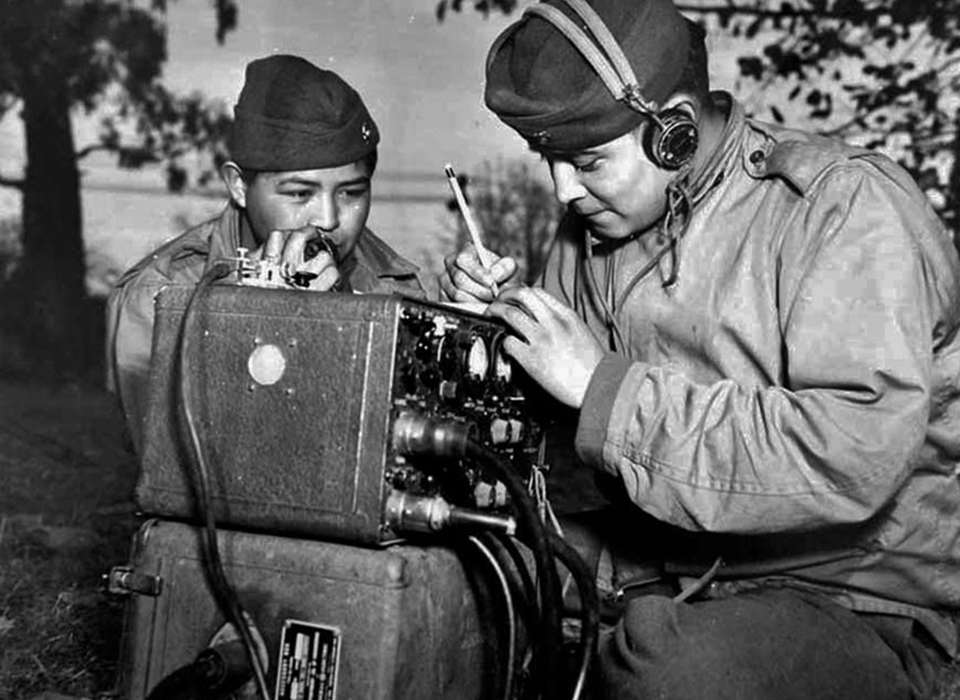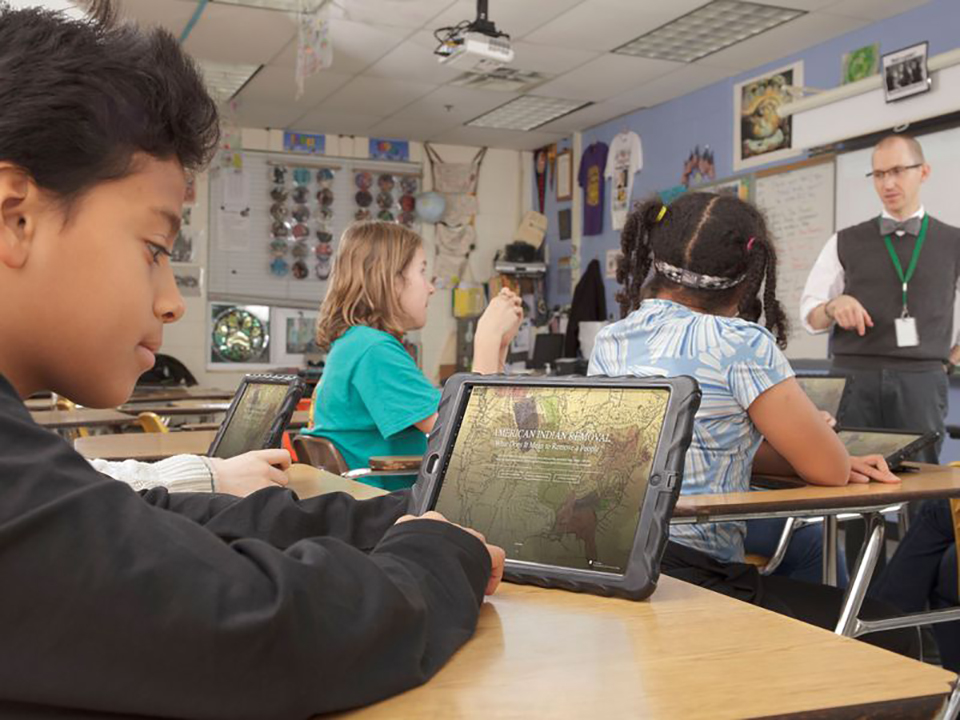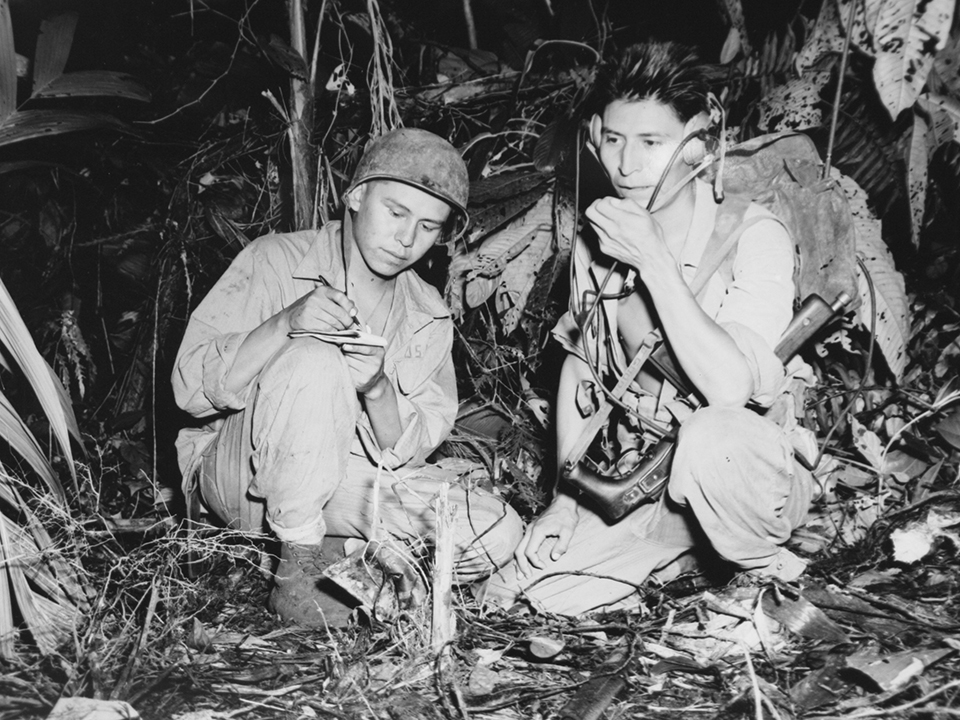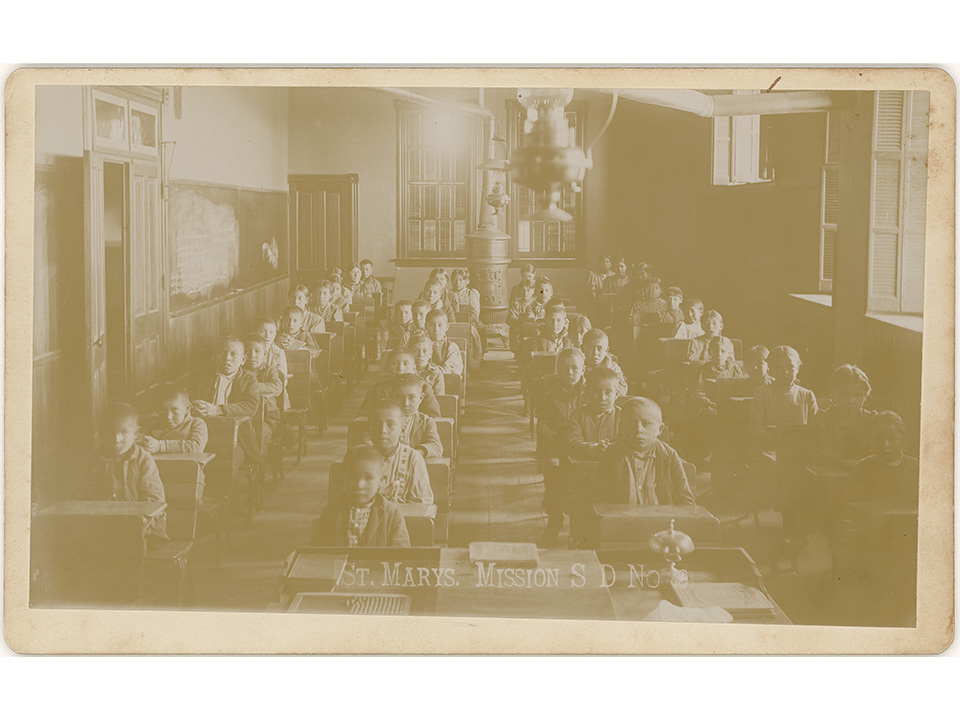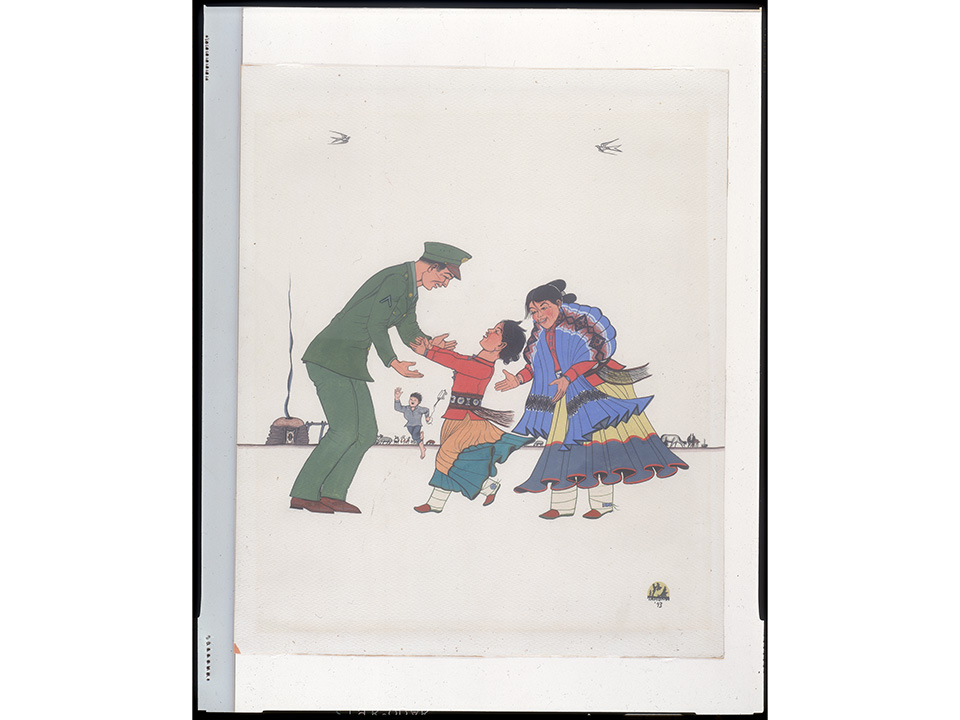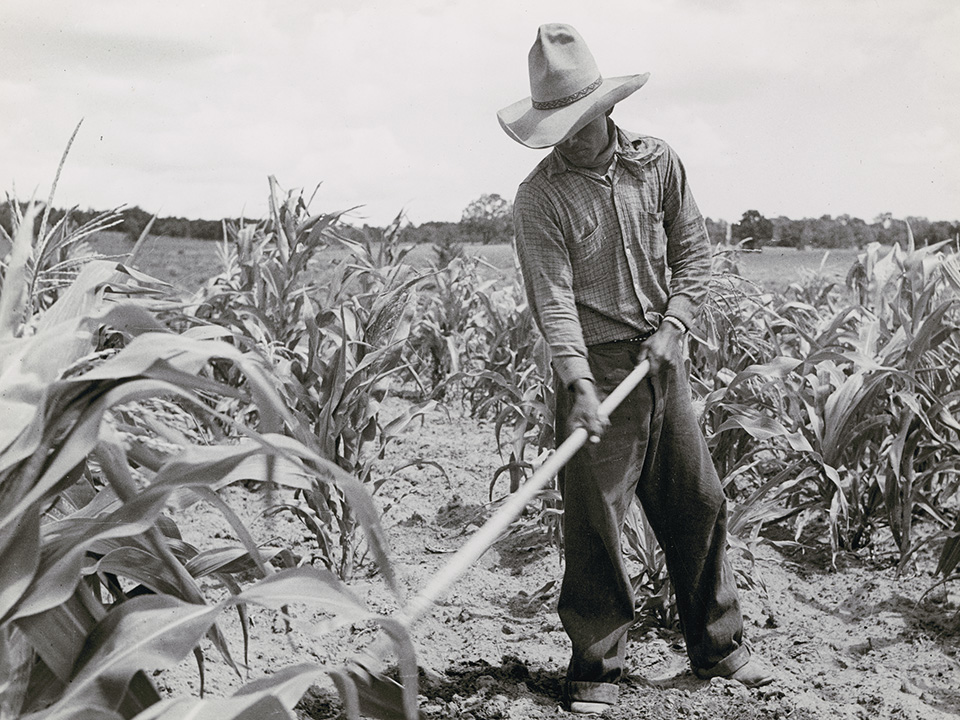Top image: Two Navajo Code Talkers. Photograph, courtesy of the National Archives and Records Administration, 127-GR-1375-7875
November’s annual Native American Heritage Month and the national holiday of Thanksgiving are times when many educators across the country turn their focus to lessons about Native Peoples. At the National Museum of the American Indian, we receive many requests during November from teachers and parents looking for advice and resources to help them teach appropriately about American Indians.
Think back to what you learned about American Indians as a student. You might remember iconic but incomplete stories, such as Pocahontas, Thanksgiving, and the Cherokee Trail of Tears. These ubiquitous stories are not wholly inaccurate, nor on their own offensive. However, they reveal that many Americans remain largely uninformed and misinformed about the diversity of historical and contemporary events that include American Indian knowledge, experiences, and perspectives.
The Smithsonian’s National Museum of the American Indian, in partnership with Native communities, wants to help change that. By offering more complete knowledge of American Indians through rich resources and thoughtful content, we better support public understanding of historical and contemporary events in a more informed context. This long-term initiative, Native Knowledge 360° (NK360°), provides educators and students with deeper and more comprehensive knowledge and perspectives about Native Peoples, bringing the richness of the museum’s collections, scholarship, and the diverse voices of Native experts directly into classrooms nationwide.
This November we are excited to launch a newly redeveloped website about American Indian Code Talkers, Native Words, Native Warriors. While many Americans are familiar with the idea of “code talkers,” knowledge about the fuller lives, stories, and experiences of American Indian Code Talkers is incredibly limited. This digital resource explores the lives and experiences of the service members who used their traditional tribal languages to transmit secret messages for the US military during World War I and World War II.
The perspectives, voices, images, and powerful stories contained in the Native Words, Native Warriors website demonstrates how an NK360° resource provides larger cultural and historical context to important events in US history. This approach encourages deeper appreciation of and respect for the complex and difficult challenges that American Indian Code Talkers faced as Native American people of the twentieth century.
Corporal Henry Bahe Jr. and Private First Class George H. Kirk, Bougainville, December 1943. United States Marine Corps photograph, courtesy of the National Archives and Records Administration, 127-MN-69889-B
For thousands of years, American Indian people have protected their communities and lands. “Warrior” is an English word that has come to describe those who provided such protection. But their traditional roles involved more than fighting enemies. They cared for people and helped in many ways, in any time of difficulty. Despite everything that American Indians have endured in the past, the warrior tradition—the tradition of protecting their people—called many of them to serve in the US military in many capacities. Code talking was one of many forms of service and sacrifice that American Indians performed.
The Native Words, Native Warriors website is composed of seven chapters and includes a collection gallery that contains captioned photographs, maps, and documents, as well as other primary sources to examine. In the chapters “Native Languages” and “Boarding Schools,” users learn about the importance of Native languages to express culture. These chapters describe the enormous pressures and deliberate systems that the United States used to eliminate traditional American Indian ways of life and replace them with mainstream American culture.
St. Mary’s Mission School students, Rosebud Reservation, South Dakota, ca. 1900. Photograph, the Smithsonian’s National Museum of the American Indian, Dr. and Mrs. Pal Kelemen Collection, P19493
The chapter “Code Talking” gives direct attention to code talkers’ experiences in combat. Not only did American Indian service members have to navigate the dangers of combat, they also had to grapple with the idea that they were fighting on behalf of a nation that had gone to great lengths to destroy their cultures and ways of living. The fact that many American Indian Code Talkers used elements of their culture as a source of strength demonstrates a resolve to persist despite adversity.
In the chapter “Coming Home,” readers clearly see that service in war has long lasting effects. Through the testimonies of Native veterans, historical images, and other primary sources, users see that for American Indians, returning home means going back to a place—a land, a community, a family, and a culture—that they were part of, a place to which they belong.
After World War II, most American Indian Code Talkers returned to communities that were experiencing difficult economic times. The chapter “Survival” gives attention to the difficult realities facing many Native veterans. Jobs were scarce, and so were opportunities for education or job training. Discriminatory practices against Native Peoples negatively affected Code Talkers’ opportunities to achieve economic and social success. Native veterans, however, did not give up.
The website concludes with a chapter about the recognition Code Talkers received following their service in war. The stories and experiences showcased in Native Words, Native Warriors make evident that the Code Talkers’ achievements were many. American Indian veterans were incredibly proud to have served on behalf of their tribal nation and the United States. However, recognition for the Code Talkers was slow to develop. They were not acknowledged for many years despite their sacrifices and important role in winning the war.
As a resource for students and teachers, Native Words, Native Warriors features several interactive features to encourage student interest and involvement. Students can examine images on-screen and explore the gallery for additional images. Most of the images on the site can be printed. Teachers may decide to use all elements of the website or focus on one or two chapters. For example, while the “Boarding Schools” chapter presents the topic of boarding schools in the context of American Indian Code Talkers, students could analyze the sources in this chapter to better understand the troubling and complicated history of boarding schools in US history. Or a teacher might choose to have students focus only on the wartime experiences of American Indian Code Talkers by spending time in just the Code Talkers chapter. Additional guidance for using this website is included in the teacher materials for each chapter.
Critical to the goal of transforming what is taught about American Indians, NK360° materials highlight untold stories and include Native perspectives at the forefront. We invite you to explore the Native Words, Native Warriors resource and engage with Native voices, objects, images, and primary-source documents. Please spend time on the NK360° site and find additional resources for teaching and learning about American Indians. There you will also find informational resources and professional development opportunities that will help you gain a deeper appreciation of the rich diversity, experiences, and perspectives of American Indians, both in the past and today.
Meet the Authors
Edwin Schupman, a citizen of the Muscogee (Creek) Nation of Oklahoma, is the manager of Native Knowledge 360° (NK360°) at the Smithsonian’s National Museum of the American Indian. Ed began his career in the field of American Indian education in 1988 working for ORBIS Associates, an American Indian education firm, creating culture and standards-based lessons on Native American topics, training teachers nationwide, and evaluating educational projects. In 2004, he joined the education staff at the National Museum of the American Indian.
Colleen Call Smith serves as an Education Specialist (Materials Developer) in the National Museum of the American Indian’s Office of Education. She earned her master’s degree in secondary education from the University of Kentucky and taught middle and high school social studies for a number of years in Kentucky, Virginia, and Washington, DC. Colleen supports the education office in the research, development, writing, and production of online resources for the Native Knowledge 360° initiative.
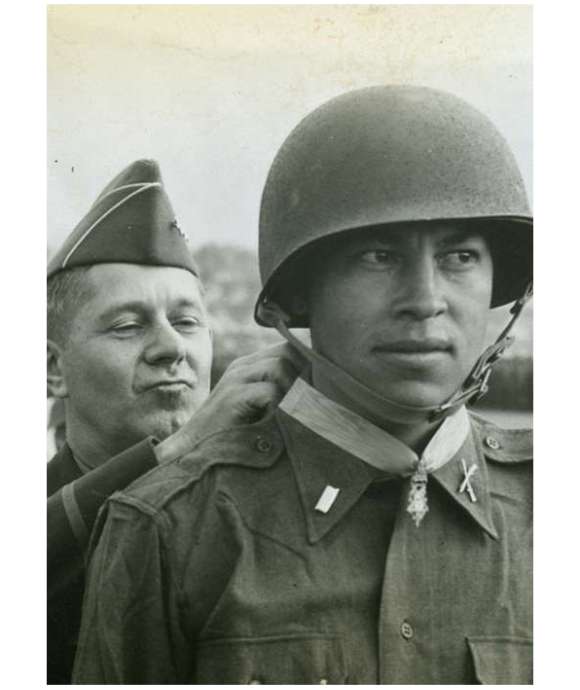
Second Lieutenant Ernest Childers, US Army: Medal of Honor Series
A member of the Muscogee (Creek) Nation, Ernest Childers became the first Native American to be awarded the Medal of Honor in World War II.
Cite this article:
MLA Citation:
APA Citation:
Chicago Style Citation:
